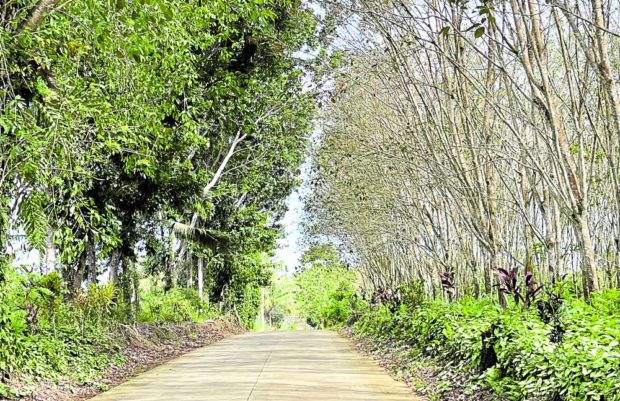
INFESTATION | Rubber trees (right) start to dry up in this plantation in Lamitan City. Rubber tappers in Basilan thought it was premature wintering until a plant pathologist from the Philippine Rubber Research Institute confirmed it was an infestation by a fungus called Pestalotiopsis microspora, which caused the leaves to wilt. (Photo by JULIE S. ALIPALA / Inquirer Mindanao)
LAMITAN CITY, Basilan, Philippines — Agriculture officials in Basilan have expressed alarm over a disease infecting rubber trees in the province which, if left unchecked, could threaten 50,000 hectares of rubber plantation and affect some 17,000 workers.
Already, trees in more than 1,000 ha of rubber plantations in nine towns and two cities have shown symptoms of the disease earlier mistaken to be premature wintering.
Basilan Gov. Jim Salliman on Monday signed the Sangguniang Panlalawigan resolution declaring the entire province under a state of calamity.
“It’s very alarming. Our people are dependent on the rubber industry and we need all the help to rehabilitate the dying trees and prevent the further spread of the disease,” Salliman said.
Earlier, Eugenio Madayao, 57, a rubber tapper in one of the plantations here, expressed concern over what he first thought was the premature wintering of rubber trees.
“We just hope it’s just about the climate,” he said in Chavacano, adding that he noticed that the changes in appearance of the trees came too early.
A tapper since his late 20s, Madayao said he was aware of the seasonal changes in trees.
“‘Wintering’ usually comes during summer, when leaves would turn yellow, then orange before they fall off. But the wintering these days started much earlier,” he said. “We saw the signs since the start of November (last year) and it continued until now.”
What disturbed the tappers was the sudden drying of leaves, without passing through the usual color changes before these fall off from the branches; and then, the trees failing to leaf afterward.
“The twigs and branches would turn grayish brown, then the leaves suddenly dry up,” Madayao said.
Experts’ confirmation
Sorhayda Aguisandra, provincial agriculturist, said many rubber tappers thought it was premature wintering but what actually was afflicting the trees was a plant disease caused by Pestalotiopsis microspora, a species of endophytic fungus capable of breaking down and digesting polyurethane, as shown in the drying of foliage and branches of rubber trees.
Among its indications is the circular spots found on leaves which gradually would turn brown, later turning the entire tree bald and dry.
Aguisandra said they first detected this sometime in 2021. Like Madayao, they also thought it was just premature wintering, until a team from the Philippine Rubber Research Institute (PRRI), which was conducting an artificial intelligence project involving rubber trees in December, discovered the disease.
She said around 1,570 ha of rubber trees in nine towns and the two cities of Lamitan and Isabela had been affected. The affected towns are Al Barka, Hadji Muhtamad, Lantawan, Maluso, Sumisip, Tabuan-Lasa, Tipo-Tipo, Tuburan and Ungkaya Pukan.
In our assessment, almost 90 percent of rubber trees in the nine towns and two cities are infected, except for the towns of Mohammad Ajul and Akbar, of which rubber trees were only 10 to 15 percent infected,” Aguisandra said.
Major livelihood
Basilan is home to rubber plantations. The province engages in large-scale rubber planting covering more than 50,000 ha, with 11 major cooperatives and thousands of farmers and small plantations engaged in it.
“Some of these rubber cooperatives employ between 300 and 500 workers. We have some rubber planters and farmers who own 2 to 10 ha of land planted to rubber, with tappers numbering around 10 to 30. We also have individual farmers,” Aguisandra said.
Based on initial assessment, more than 17,000 rubber tappers will be affected in the province, if there will be a work stoppage, which is inevitable, she added.
“It’s a conservative estimate for now until we get all their names,” she said.
Aguisandra cited the recommendations of PRRI pathologist Gail Villanueva, who informed the province that they were already facing a rubber disease epidemic and that rubber tapping had to be stopped for at least three months to fertilize and declutter the ground.
“Naturally, when tapping stops, workers will not be earning a living, so this will really affect the economy of Basilan,” Aguisandra said.
Salliman said the calamity fund will be used to assist affected farmers, workers, and tappers, and support the affected rubber cooperatives. Part of the fund will also be used to acquire fungicides, drone sprayers, and other farm inputs to rehabilitate the trees.